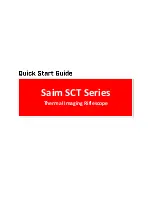
the same direction. The defocused star must go near the edge of the field of view at the "8
o'clock" position, like in "C".
7. Try to tight or loose a bit one of the collimation screws of the primary mirror. Discover
which screw (or screws) move the star image in the direction of the center of the field of
view (like the black arrow in "C"). When the image will go back to the middle of the field of
view, it will be more centered.
8. Repeat steps 4-7 until you reach collimation (image "A", above). Take your time and try to
do the best you can.
9. Change the eyepiece with a more powerful one (shorter focal length) and repeat steps 4-8.
For this step a magnification of around 300x is a good choice.
10. When the image is centered and looks perfectly symmetrical at high magnification, your
telescope is collimated. Proceed to the “fine collimation” procedure.
Some hints about this procedure.
•
If the dark shadow of the secondary mirror looks in the middle of the white circle, change a
bit the focus, using the focuser, NOT the electric motor of the secondary mirror, if present.
The white disk will became smaller or bigger. Check if the shadow is always in the middle
(the human eye is a very good "device" to control if two circles are concentric). Always
keep the image in the center of the field of view using the telescope mount. Focus from a
"very big" to a "very small" image, and continue to check if the shadow is always in the
middle of the white spot. Find the size of the spot that is more comfortable for your eye to
detect concentricity. If you are using a camera you may have to change exposure time; you
may also measure the single images using specific software (or a cheap ruler, working
directly on the computer screen).
•
If the image is too bright or too dim to see clearly the shadow of the secondary mirror,
choose a different (dimmer or brighter) star, or change exposure time accordingly.
•
If the shadows always look concentric even with a high power eyepiece, the collimation of
your scope is "good enough" for any reasonable application. Go to the next section, "Fine
collimation".
The image at left gives you an idea about
what you will see during this procedure
while you change focus. Here is telescope
is well collimated.
Remember, always keep the star in the
center of your field of view, using the
telescope mount.
It is very unlikely you have to move any collimation screw more than one turn – probably you
will reach collimation with less than half a turn.
Have someone to help you while you look at the eyepiece – or use a camera so you can see
the image while you work on the screws. It is a good idea to label the three collimation "A", "B",
and "C", and memorize the direction of the movement given by each screw. Obviously the star
will move in the opposite direction along a straight line when you turn screw "A" clockwise or
counterclockwise. Movements due to screws "B" and "C" will be 120° apart.
In all
Officina Stellare
telescopes the collimation screws are spring-loaded using special zero-
backlash cup springs, so if you tight one screw there is no need to untight the other two.
And, very important: KEEP YOUR TIME, AND START WITH SMALL MOVEMENTS (say 1/16
of a turn). It is a good idea to mark the initial positions of collimation screws with a felt tip pen
and keep track of what you do (like “screw A 45° CW – screw B CCW 30°...” and so on). Doing
so, you will always be able to “undo” a wrong action.
29


































